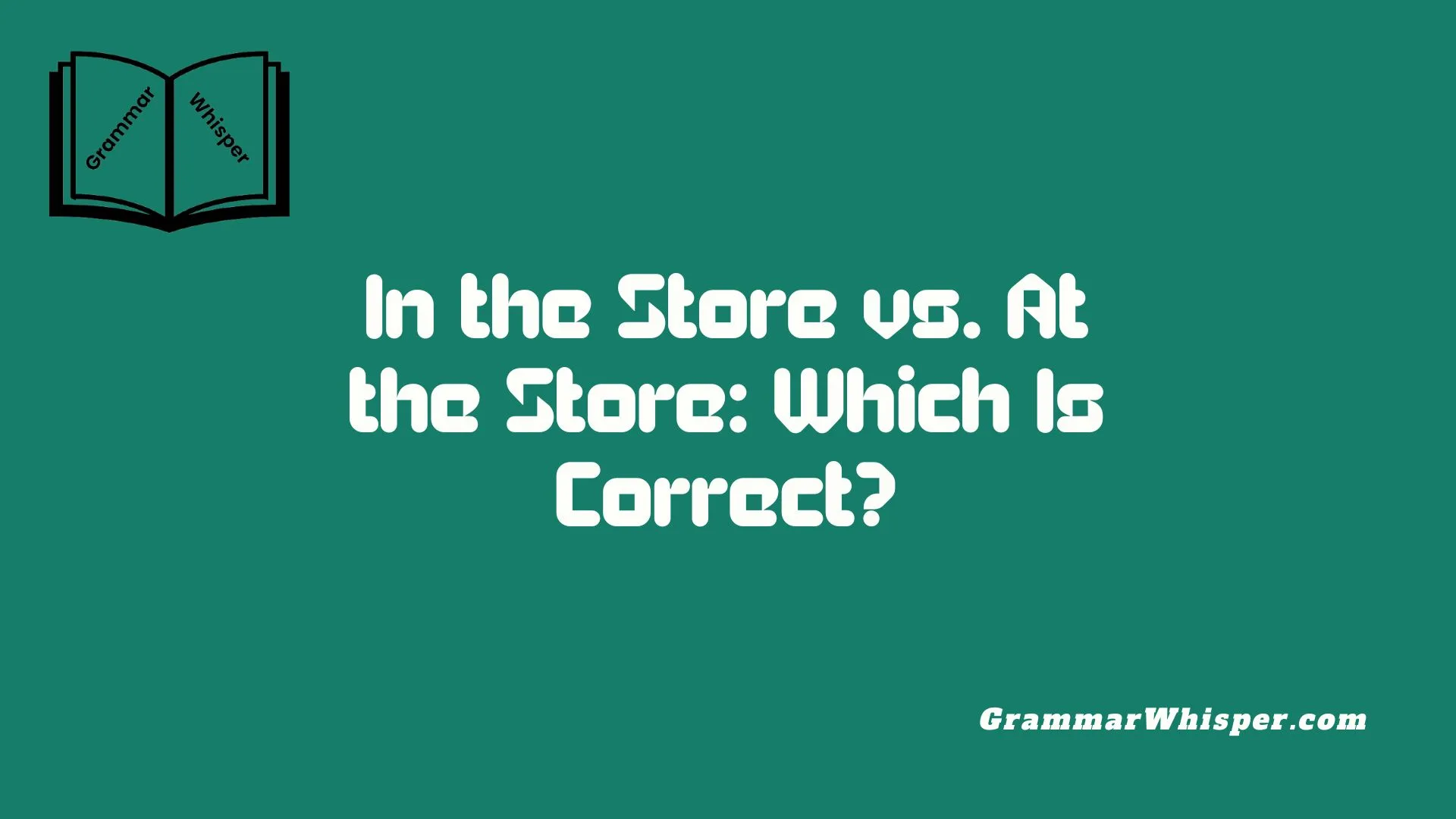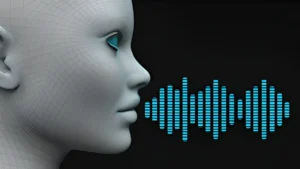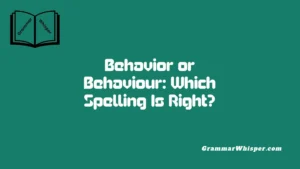As a language coach, I often see learners of English get puzzled by small details that native speakers take for granted. One common challenge is decoding prepositions like “in the store” vs. “at the store.” It may sound like a grammar secret, but trust me – it’s easier than it seems. When you say, “I’m at the store,” you’re talking about your location in a general way. But if you say, “I’m in the store,” you’re giving a clearer picture – you’re literally inside, among the shelves. These phrases look similar, but each paints a different sense of place. The difference may be subtle, but it’s worth noticing.
A quick mental guide has helped my students: think of “at” as the dot on a map, and “in” as being inside the building. This breaks down the confusion with real-world usage. If someone’s asking where you are, and you’re waiting in the parking lot, say you’re at the store. But if you’re browsing inside, say you’re in it. These small shifts can boost how you speak and write, and they also build confidence. It’s not about rules – it’s about having the right tools to spot the difference, and this kind of insight really helps in daily conversation.
The Core Difference Between “In the Store” and “At the Store”
- “In the store” means inside the building.
- “At the store” points to your presence at the location, not necessarily inside.
Visual nuance:
In → you’re in the aisles. At → you could be outside, nearby, or just referencing the place.
Native speakers often choose subconsciously based on whether they focus on being inside or the location itself.
Grammar Mechanics: How “In” and “At” Work
Prepositions link nouns to places or actions. Here’s a fundamental table illustrating space vs. general location:
| Preposition | Spatial Meaning | Conceptual/Location Meaning |
| In | Inside: “I’m in the store.” | Enclosed spaces: in the box, in the city |
| At | General point: “I’m at the store.” | Points in space: at the door, at 5 pm |
Use in when you mean being within an area. Use at to point to a specific location or event.
Usage in Different Contexts
Physical Location vs. Activity
- In the store – emphasizes being inside, possibly shopping.
- At the store, it works for being close by or referring to the event.
Example:
“I’m in the store picking out cereal.” “I’ll meet you at the store in ten minutes.”
Focus on Action vs. Place
- Action-focused: “I’m in the store, grabbing milk.”
- Location-focused: “I’m at the store, but I haven’t gone inside yet.”
Subtle Shifts in Meaning From Prepositions
The tiny prepositions change emphasis:
- “I’m at the store” → location announcement.
- “I’m in the store looking for detergent.” → inside, a specific task.
Key takeaway: Use in for action inside, at for general presence or reference.
Common Mistakes and How to Avoid Them
English learners often confuse these because many languages don’t make the distinction. Mistakes happen when:
- Translating directly (“Estoy en la tienda” → “I’m in the store” may be correct, but context matters).
- Not distinguishing between place vs. inside.
Common mix-ups:
- Saying “I’m in the store” when you’re outside.
- Saying “I’m at the store” when you’re browsing inside.
Fix: Think – Am I inside or just pointing out the place?
Real-World Examples in Conversation
Dialogue 1: Customer & Friend
- Friend: “Where are you?”
- You: “I’m at the store, the line at the entrance is long.”
- Later: “I’m in the store, found the cereal section.”
Dialogue 2: Text to a spouse
- “Hey, I’m at the store. Need anything?”
- Response: “Can you check in the store for paper towels?”
Regional and Dialectal Differences
American vs. British English
- Americans: “at the hospital” or “in the hospital” depending on context.
- Brits often drop the “He’s at the hospital” to mean he’s admitted.
Urban vs. Rural Speech
In casual conversation – particularly in small towns – you’ll hear both used, but emphasis shifts based on what the speaker wants to focus on.
Google Ngram Analysis
A Google Ngram search (1950–2020) reveals:
- “In the store” peaked in the 1980s–1990s.
- “At the store” holds a steady higher frequency, showing its broader general usage.
Analogous Preposition Pairs
| Pair | Use of “In” | Use of “At” |
| In/At school | Inside the building/classroom | on campus/in the general vicinity |
| In/At the office | physically inside the office space | part of the workplace/company location |
| In/At the hospital | admitted as a patient | present on premises, visiting, or working |
Mnemonic: If you’re inside an environment, say in. If you’re referencing the location or event, it’s your best bet.
Workplace Prepositions: “Work In” vs “Work At”
- Work in marketing – area of expertise.
- Work at Google – employer location.
Example:
“She works at Google in their Brooklyn office.” “He works in software development.”
Tips to Speak With Precision
- Default rule:
- Use in → if you’re inside.
- Use at → to reference the place in general.
- Spot the action word: If your voice highlights the task (“looking,” “shopping”), in fits.
- Keep it short: “I’m in” = inside; “I’m at” = location.
Conclusion: Preposition Mastery Is Context + Intent
- In shows being inside.
- It suggests being at the location.
- Most misunderstandings stem from direct translation or skipping context.
- The key: ask yourself what matters – action or place?
Bonus Quick Reference
| Scenario | Use “In” | Use “At” |
| You’re shopping inside | ✅ In the store | |
| You’re waiting at the entrance. | ✅ At the store | |
| Describing a general meetup location | ✅ At the store | |
| Discussing what’s happening inside | ✅ In the store, they’re stacking shelves. |
Conclusion:
Understanding when to use “in the store” versus “at the store” comes down to one powerful tool: context. If you’re emphasizing your physical presence inside the store – among the aisles or at the checkout – go with in. If you’re referencing the location itself or your general whereabouts, choose at.
Prepositions may seem small, but they influence how clearly you’re understood. Whether you’re texting a friend or giving directions, the subtle distinction between in and at can shift the meaning of your sentence entirely.
In daily communication, people may use these interchangeably without major confusion. But if your goal is clear, natural, and grammatically precise English, mastering this nuance will set your speaking and writing apart. Use the tables, examples, and patterns from this guide as your foundation, and you’ll never be unsure again.
FAQs
Why is “at the store” more commonly used than “in the store”?
Because “at the store” serves as a broader reference. It’s often used to refer to someone’s general location, even if they are not physically inside. It’s also quicker and more flexible in everyday speech. For example: “She’s at the store” covers everything from parking in the lot to being in the checkout line.
Can I say “in the store” if I’m talking on the phone from inside?
Absolutely. If you’re physically inside the store, “in the store” is both accurate and descriptive. Saying, “I’m in the store – it’s noisy here,” tells your listener exactly where you are and what you’re experiencing.
Is there a difference in tone or formality between the two?
Not significantly. Both are neutral and common in informal and formal communication. However, “in the store” can sound slightly more specific and detailed, while “at the store” is more general and commonly used in brief or casual exchanges.
How do I know which one to use in writing versus speaking?
In writing, especially formal or instructional, “in the store” should be used when the subject’s physical presence inside matters. In speech, “at the store” is more commonly used for simplicity. But again, it all depends on what you want to emphasize: the location (at) or the interior space (in).
Does the same rule apply to places like “school,” “office,” and “hospital”?
Yes, and it’s one of the best ways to internalize the rule. For example:
- “He’s at school” (location/general reference)
- “She’s in school” (enrolled in education)
- “I’m in the office” (physically inside)
- “He works at the office” (company reference)











